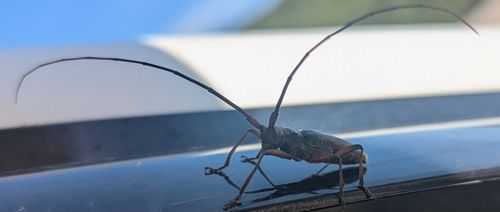Longhorn Beetle
Scientific Name: Cerambycidae (Family)
Order & Family: Order: Coleoptera, Family: Cerambycidae
Size: Most species range from 2 cm to 8 cm in length, excluding antennae. Some can be smaller or larger.

Natural Habitat
Forests, woodlands, and areas with dead or living trees, as their larvae (grubs) typically bore into wood.
Diet & Feeding
Adult longhorn beetles typically feed on pollen, nectar, sap, or sometimes leaves and bark. Larvae (grubs) are wood-borers and feed on the wood of trees, either living, dying, or dead.
Behavior Patterns
Adults are often nocturnal, attracted to lights. Many species can make a stridulating (squeaking) sound when handled or disturbed. Females lay eggs in crevices of bark or on the surface of wood. The larvae bore into the wood, where they can live for several months to several years, depending on the species and conditions. Pupation occurs within the wood.
Risks & Benefits
Potential Risks: Some species are considered significant pests of trees, particularly timber and ornamental trees, as their larval wood-boring activity can weaken or kill trees, and infest cut lumber. Examples include the Asian longhorned beetle, which is an invasive species that poses a serious threat to various hardwood trees. Potential Benefits: As decomposers, larvae help in breaking down dead wood, contributing to nutrient cycling in forest ecosystems. They also serve as a food source for other animals.
Identified on: 9/4/2025